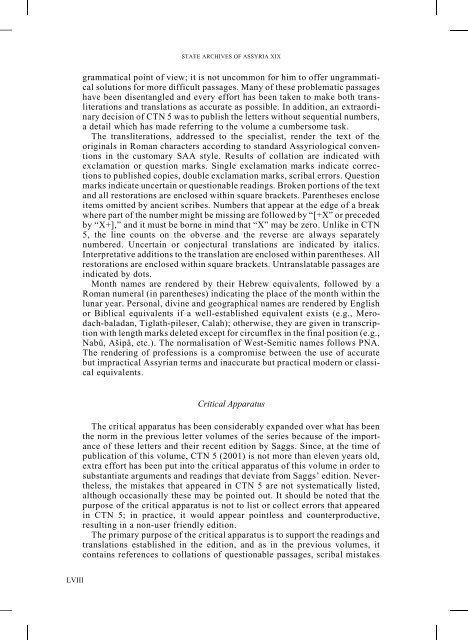Download PDF version of SAA 19 introduction - UCL
Download PDF version of SAA 19 introduction - UCL
Download PDF version of SAA 19 introduction - UCL
You also want an ePaper? Increase the reach of your titles
YUMPU automatically turns print PDFs into web optimized ePapers that Google loves.
STATE ARCHIVES OF ASSYRIA XIX<br />
grammatical point <strong>of</strong> view; it is not uncommon for him to <strong>of</strong>fer ungrammatical<br />
solutions for more difficult passages. Many <strong>of</strong> these problematic passages<br />
have been disentangled and every effort has been taken to make both transliterations<br />
and translations as accurate as possible. In addition, an extraordinary<br />
decision <strong>of</strong> CTN 5 was to publish the letters without sequential numbers,<br />
a detail which has made referring to the volume a cumbersome task.<br />
The transliterations, addressed to the specialist, render the text <strong>of</strong> the<br />
originals in Roman characters according to standard Assyriological conventions<br />
in the customary <strong>SAA</strong> style. Results <strong>of</strong> collation are indicated with<br />
exclamation or question marks. Single exclamation marks indicate corrections<br />
to published copies, double exclamation marks, scribal errors. Question<br />
marks indicate uncertain or questionable readings. Broken portions <strong>of</strong> the text<br />
and all restorations are enclosed within square brackets. Parentheses enclose<br />
items omitted by ancient scribes. Numbers that appear at the edge <strong>of</strong> a break<br />
where part <strong>of</strong> the number might be missing are followed by “[+X” or preceded<br />
by “X+],” and it must be borne in mind that “X” may be zero. Unlike in CTN<br />
5, the line counts on the obverse and the reverse are always separately<br />
numbered. Uncertain or conjectural translations are indicated by italics.<br />
Interpretative additions to the translation are enclosed within parentheses. All<br />
restorations are enclosed within square brackets. Untranslatable passages are<br />
indicated by dots.<br />
Month names are rendered by their Hebrew equivalents, followed by a<br />
Roman numeral (in parentheses) indicating the place <strong>of</strong> the month within the<br />
lunar year. Personal, divine and geographical names are rendered by English<br />
or Biblical equivalents if a well-established equivalent exists (e.g., Merodach-baladan,<br />
Tiglath-pileser, Calah); otherwise, they are given in transcription<br />
with length marks deleted except for circumflex in the final position (e.g.,<br />
Nabû, Ašipâ, etc.). The normalisation <strong>of</strong> West-Semitic names follows PNA.<br />
The rendering <strong>of</strong> pr<strong>of</strong>essions is a compromise between the use <strong>of</strong> accurate<br />
but impractical Assyrian terms and inaccurate but practical modern or classical<br />
equivalents.<br />
Critical Apparatus<br />
The critical apparatus has been considerably expanded over what has been<br />
the norm in the previous letter volumes <strong>of</strong> the series because <strong>of</strong> the importance<br />
<strong>of</strong> these letters and their recent edition by Saggs. Since, at the time <strong>of</strong><br />
publication <strong>of</strong> this volume, CTN 5 (2001) is not more than eleven years old,<br />
extra effort has been put into the critical apparatus <strong>of</strong> this volume in order to<br />
substantiate arguments and readings that deviate from Saggs’ edition. Nevertheless,<br />
the mistakes that appeared in CTN 5 are not systematically listed,<br />
although occasionally these may be pointed out. It should be noted that the<br />
purpose <strong>of</strong> the critical apparatus is not to list or collect errors that appeared<br />
in CTN 5; in practice, it would appear pointless and counterproductive,<br />
resulting in a non-user friendly edition.<br />
The primary purpose <strong>of</strong> the critical apparatus is to support the readings and<br />
translations established in the edition, and as in the previous volumes, it<br />
contains references to collations <strong>of</strong> questionable passages, scribal mistakes<br />
LVIII

















